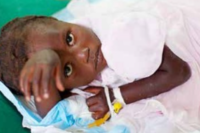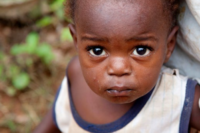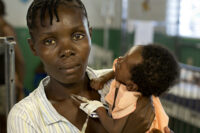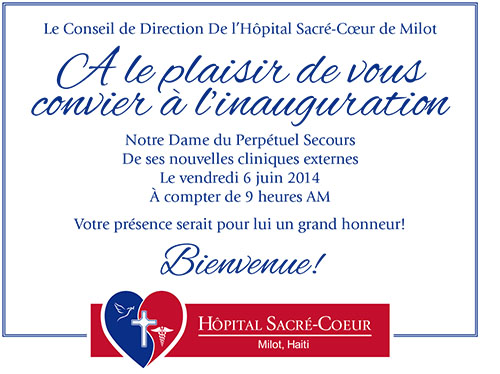
Remarks by Michael Maron, President of The CRUDEM Foundation
Monsignor Kébreau, Mrs. Martelly, Ambassador Katsuyoshi, Minister Guillaume, CMMB and CDC representatives and most importantly our specials guests and supporters, the Evans Family, Nancy Evans, Patty Bradley and her daughter Sandy Bradley, thank you for having blind faith in us, and hopefully now a greater sense of our mission and purpose here at Hôpital Sacré Coeur.
To all the staff and the leadership here in Milot, especially Dr. Prévil, the physicians, nurses, support staff and general services staff, I want to thank you; but also forewarn you, that what I am about to say applies to everyone who visits here, but it applies most importantly to you.
I remember my first trip to Milot just after the earthquake like it was yesterday. A veteran volunteer, someone who had been coming here regularly for the ten years prior, looked me in the eye and said, “I’ve seen that look before, you think you are going to make a difference here, you are going to change Haiti.” He went on to say, “I hate to rain on that thought, but it won’t happen. We can’t change Haiti. Haiti suffers from centuries of problems and I don’t think people here really care about change; they just care about survival and getting out of Haiti if they can. All we can do is offer brief episodes of help and relief, nothing more.”
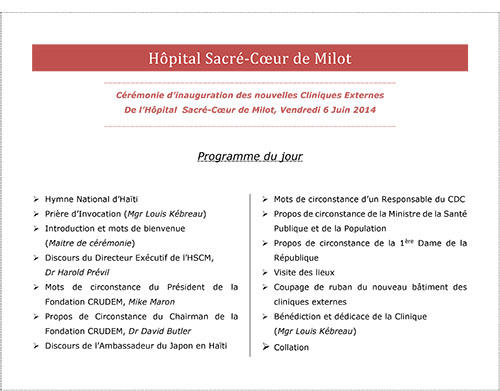 I can stand here today and tell you that was bad advice. We can change. You can change.
I can stand here today and tell you that was bad advice. We can change. You can change.
If I can only influence 5 of you…and then those 5 in turn influence 5 more each and it takes a full year to get someone to believe in the change enough so that they go out and try to change 5 more…Well if that were to happen, then in less than 10 years we will have changed 2 million people — the same size of the population in northern Haiti. Expand that to 10 people influencing 10 more people each and so on, then in 10 years you have the ability to influence 10 million people. The very same number of people that lives in all of Haiti today.
We can change Haiti. Ou ka chanje Ayiti.
So the real question is how?
1. Our words and promises must be backed by action and deeds. Otherwise they are just cheap words. Vision without action is just a dream. Action without vision just passes the time. Vision with action can change Haiti.
2. We must put the interests and needs of others ahead of our own. Those of us who are better off, better educated, better fed must make sacrifices for those who are not as fortunate. The leaders cannot believe they are privileged and entitled. They must be servants to the vision, servants to the actions required to change the community.
3. We must respect everyone as if they were part of our own family.
4. We must build trust by acting consistent, honoring our promises, and speaking truthfully, even when the truth hurts.
5. We must behave responsibly and hold each other and ourselves accountable for our actions. We will make mistakes, we will admit to them, we will learn from them, and we will not repeat them.
 Many of you often remind me, my skin is a different color, but if you cut me, we bleed the same blood, feel the same pain and in the end we will all die and leave this earth. In Haiti according to the World Health Organization your average life expectancy is 63 years. In the U.S. it’s 79 years.
Many of you often remind me, my skin is a different color, but if you cut me, we bleed the same blood, feel the same pain and in the end we will all die and leave this earth. In Haiti according to the World Health Organization your average life expectancy is 63 years. In the U.S. it’s 79 years.
In Japan it’s 85 years. If you are 40 years of age then in Haiti you only have 23 years or 276 months, to leave your mark, to make a difference, to give purpose and meaning to your life.
Today we celebrate a milestone exemplified in the physical building of the new clinic space. But do not lose sight, the success of Hôpital Sacré Coeur will not be defined by the buildings we construct or the equipment we use. It will be defined by the attitude of the people and the new culture of caring we create.
I ask you now to make a commitment and every time you look at this building, or use the equipment you remind yourself that you are:
1. Committed to change
2. Committed to foster hope
3. Committed to compassionate care
4. Committed to learn
5. Committed to be held accountable and act responsibly
6. Committed to put others ahead of yourself
7. Committed to be courageous and strong when others challenge the change.
And most of all, that you are committed to influence at least 10 others so that in 10 years Haiti will achieve a new vision — a new dream.
Ou ka chanje Ayiti
Remarks by Hôpital Sacré Coeur CEO, Dr. Harold Prévil
 Monsignor Kébreau, Mrs. Martelly, Ambassador Katsuyoshi, Minister Guillaume, members of the Evans family, Reverend Clergy, Colleagues, Friends, Ladies and Gentlemen welcome to Hôpital Sacré Coeur and thank you for joining us for this important moment in the life of our hospital: the dedication of the Notre Dame du Perpétuel Secours Clinic. You honor the hospital and its mission by your presence here today.
Monsignor Kébreau, Mrs. Martelly, Ambassador Katsuyoshi, Minister Guillaume, members of the Evans family, Reverend Clergy, Colleagues, Friends, Ladies and Gentlemen welcome to Hôpital Sacré Coeur and thank you for joining us for this important moment in the life of our hospital: the dedication of the Notre Dame du Perpétuel Secours Clinic. You honor the hospital and its mission by your presence here today.
I want to begin by introducing you to Hôpital Sacré Coeur’s Board of Management and the Chiefs of Service:
• Jacques Julmice, Chief Medical Officer
• Nathalie Dorcin, Chief Nursing Officer
• Michel Fitzgerald, Chief Financial Officer
• Abdel Alexis, Director of Human Resources
I am privileged to call these men and women my colleagues. Together we lead one of the finest hospitals in Haiti. And like many great institutions in this country, Hôpital Sacré Coeur had a humble beginning. In 1968, the Montreal Province of the Brothers of the Sacred Heart, came to Milot and built a small dispensary and then a 20 bed hospital. When the Brothers left Milot in 1993, the Archbishop of Cap Haïtien entrusted Hôpital Sacré Coeur to The CRUDEM Foundation, which has financially supported and supervised the hospital ever since. With the steadfast, faithful support of Monsignor Kébreau and his predecessors — for which we are very grateful — Hôpital Sacré Coeur has grown as it sought to keep pace with the needs of the region. But the hospital’s mission has always reached beyond Milot.
In the dark days following the 2010 earthquake, Hôpital Sacré Coeur surged from 72 beds to more than 400 beds. Hour after hour, helicopters ferried the injured to Milot for admission to our hospital. And just when the urgency and drama of the earthquake began to ebb, one of the great scourges of humankind — Cholera — struck the Artibonite river valley and quickly spread throughout Haiti. Hôpital Sacré Coeur opened one of the country’s first cholera wards.
Today, Hôpital Sacré Coeur is a 125 bed tertiary care facility with over 350 employees, augmented by hundreds of medical volunteers from the United States. In 2013, our hospital admitted some 6,000 inpatients, performed over 1,900 surgical procedures, provided HIV testing and counseling services to some 11,000 people, saw nearly 50,000 patients in the outpatient clinic and hosted more than 400 volunteers.
The earthquake and cholera outbreak brought record numbers of patients to Hôpital Sacré Coeur but little in the way of financial assistance. Our donors remained faithful and generous but did not substantially grow in number; and certainly not at a rate to keep pace with the seemingly endless flow of victims of these two tragedies. So it was all we could do to keep our doors open, let alone build much-needed infrastructure. We hoped for a miracle and we got one. In 2012, Holy Name Medical Center of Teaneck, New Jersey stepped in to help support Hôpital Sacré Coeur — indeed it is no exaggeration to say that they saved our hospital. Thanks to the leadership of Mike Maron, CEO of Holy Name and President of The CRUDEM Foundation and Dr. Dave Butler, a member of Holy Name’s board and long-time Hôpital Sacré Coeur medical volunteer, our hospital’s financial condition is improving and our dream of a new outpatient clinic is today a reality.
We owe a debt of gratitude to Mr. Maron and Dr. Butler that we can never fully repay. Thank you both for the unconditional love you have given to our hospital and the people we serve.
But even with Holy Name’s support, the Notre Dame du Perpétuel Secours Clinic would not have been built without the generous support of our donors and friends. In particular, I want to recognize Mary and the late Robert Evans — and the entire Evans family — for their support.
The Evans family is among CRUDEM’s most generous supporters and we are very grateful to them. Without them, there would be no new outpatient clinic at Hôpital Sacré Coeur.
And it was at the request of Mary Evans that the new building was named for the patroness of Haiti, Notre Dame du Perpétuel Secours. Mary could not be here with us today, but her two daughters Nancy Evans and Patricia Evans Bradley as well as a granddaughter, Sarah Jane Bradley, are here and I want them to know how much we appreciate the kindness of the Evans family.
The new clinic building also received generous support from the Government of Japan. The Japanese Ambassador to Haiti, Mr. Katsuyoshi, is here to help us celebrate this historic milestone for our hospital. Mr. Ambassador, though more than 13,000 kilometers separates Haiti from Japan, I want you to know that my colleagues and I at Hôpital Sacré Coeur feel a special closeness to your country. Thank you for caring about our hospital and the people we serve.
For more than a decade, Hôpital Sacré Coeur has been the beneficiary of the financial assistance and other support from the United States government. Evidence of the generosity of the people of the United States can be seen in almost every square foot of the hospital. And the Notre Dame du Perpétuel Secours Clinic is no exception. Thanks to a partnership between the U.S. Centers for Disease Control and Prevention and the Catholic Medical Mission Board, funding from the U.S. government enabled us to include a suite of HIV/AIDS consultation rooms in this new facility. We are joined today by Kathy Middleton, the CDC’s Acting Country Director, and Dr. Dianne Jean-Francois, CMMB’s country director. Thank you both for your friendship and support for our hospital.
We appreciate you being here.
Thanks to these friendships and more, today we mark a historic milestone — the opening of the 9,000 square foot Notre Dame du Perpétuel Secours Clinic. With 24 examination rooms, HIV/AIDS consultation rooms, a 10 bed emergency department, and a new radiology suite and pharmacy, this new facility represents the most profound addition to our hospital since the present operating rooms were built more than a decade ago.
Together with our remodeled Intensive Care Unit and improved patient flow-plan, the inauguration of the Notre Dame Clinic ushers in a new era for patient care at Hôpital Sacré Coeur; one that will be characterized by less improvised infrastructure and more attention to high quality patient care. Thanks to all of you who helped to make this day possible.
We are honored by your support.
Remarks by The First Lady of the Republic of Haiti, Sophia Martelly
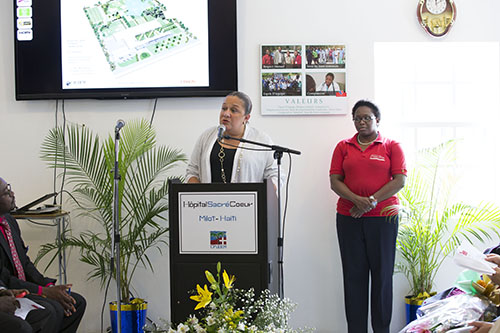 Here I am back in Milot, this time with the privilege of inaugurating a new building for Hôpital Sacré Coeur in Milot.
Here I am back in Milot, this time with the privilege of inaugurating a new building for Hôpital Sacré Coeur in Milot.
I am delighted to be here because building public services is an essential base of development and growth for any country. President Martelly has held this commitment: “Build where there is nothing, enlarge and multiply or there is very little. Such act is the politic of public interest.”
This hospital’s reputation, I am very pleased to say, is one of the most important tales in our health system in Haiti. This extension continues the hospital’s tradition of excellence in matters of care to even more people.
I salute as well, all the hospital effort deployed to control diseases such as HIV, Cholera, and very recently the Chikungunya strain. Each new center, each new building that is built constitutes a victory in our fight against these diseases and an advance towards our objective in matters of health.
I encourage every health care provider, doctor, nurse, and administrator at all levels of the chain of service to perform their share of the work with professional conscience and respect for human life. I know it’s a difficult task and a great responsibility, but thanks to you professionals, Hôpital Sacré Coeur in Milot is already a reference hospital and a model of service for all of the great North. The people expect a lot from you and they put their trust in you.
Mike, I would like to just clarify one thing: You mention in your speech that I took time away from my busy schedule to be here. I want to make it clear, that it is first of all an honor to be here with you, and it is also my duty as First Lady to be part of this movement.
Thank you, very much.
Remarks by Ambassador of Japan, Mr. Tamura Katsuyoshi
 The First Lady of the Republic, Mrs. Sophia Martelly,
The First Lady of the Republic, Mrs. Sophia Martelly,
The Minister of Public Health and Population, Dr. Florence Guillaume, The Chairman of the CRUDEM Foundation, Dr. David Butler, The President of the CRUDEM Foundation, Mr. Michael Maron, The Executive Director of Hôpital Sacré Coeur in Milot, Dr. Harold Prévil, Madame, Representative of CDC, Kathy Middleton.
Ladies and gentlemen,
I am pleased to attend today’s opening ceremony of the new outpatient clinic building of Hôpital Sacré Coeur in Milot, in the Northern Department of Haiti. Much of the contribution was supported by the CRUDEM Foundation. Japan, for its part, contributed to a portion of the new building through the program entitled “Assistance in the form of Donations to Micro-Local Projects”. That is to say, through “Project Planning: Outpatient Hôpital Sacré Coeur of Milot.” The Japanese side was built with $121,749 (USD) funding.
The activities in the field of health are of primary importance to the Government of Haiti, as well as to the Government of Japan. The project is a response to the needs of the local population, and we believe that the rehabilitation of the Hôpital Sacré Coeur in Milot is sure to help improve the health of the Haitian people in the Northern Department.
In this regard, I wish to express my deepest respects to personnel of Hôpital Sacré Coeur of Milot and the CRUDEM Foundation for their invaluable effort to complete the project.
As a referral hospital of the Northern Department, Hôpital Sacré Coeur hosts more than 40,000 outpatients and 5,000 inpatients a year and saves countless lives in the Haitian population. Since these people otherwise might suffer from the loss caused by medical expenses, the contribution of the Hôpital Sacré Coeur in Milot is really huge in terms of welfare of the Haitian people. Moreover, despite the efforts of professionals in the field of public health, access to essential health care disparities is still a major problem that appears worldwide. To mitigate these disparities, the Government of Japan has put better overall health as a pillar of its cooperative and diplomatic mission. To this end, in June 2013, the Government of Japan named the implementation of an initiative called “The Promotion of Universal Health Coverage.” Through this initiative, Japan would like to contribute with its experience, knowledge and expertise, to create a world where all individuals can receive basic medical care.
In conclusion, ladies and gentlemen, I would like once again to offer my sincere congratulations on the work of Hôpital Sacré Coeur in Milot with the great support of the CRUDEM Foundation and I assure you that Japan intends to continue its cooperation in the field of public health.
Thank you for your attention.
The Dedication Drew Attendees from All of Haiti. See more images on our Pinboards.





